-
MYOB Practice Tax (NZ) introduces a new way of working through your data reconciliation before preparing a tax return.
-
You can also view the tax notice workflow.
-
For changes, see what's new and coming soon. For the latest status of product issues, see known issues.
About data reconciliation
How it works
The Data reconciliation area of Compliance contains tax transactions you've received from IR or that you've created manually or via a tax return. For example, a transfer of credit.
These transactions represent the current and expected activity relevant to each tax year of a client.
Your tax agency is linked to IR (via Settings > Agency details) and it receives transactions on the days that IR supplies them, following overnight processing.
The transactions that you receive from IR are automatically reconciled for you if they meet the following criteria:
MYOB transaction exists.
The date is within 7 calendar days of the IR transaction.
The transaction type (for example, payment) is the same.
The amount is within 5 cents of the IR transaction.
Where a transaction doesn't have an existing MYOB transaction to reconcile with, or the properties of that IR transaction don't meet all the conditions to enable automatic reconciling, you need to manually process it instead.
-
Transactions for penalties and interest are automatically processed. Also, where IR has reversed a transaction, this will be automatically matched to the original transaction received and hidden from the display. If it can't be matched, it'll be shown as an unreconciled transaction.
-
Some MYOB transactions will be automatically created in Data reconciliation when you file a tax return after 4 November 2021.
You can access Data reconciliation from either the All clients practice-level view, or from an individual client record.
Data reconciliation All clients view
This list shows all tax clients, separated into two sections. The first section shows any tax clients with unreconciled transactions. The second section shows all other tax clients, with no outstanding transactions to be processed.
Details shown in the list include:
Client name
Entity type
Available periods – The years that data is available for.
Last refreshed date – The last date any new transactions were received for the client.
Alerts – The number of unreconciled transactions for the client, including assessments. You can view the number by hovering over the alert icon.
Comments – A comment icon (a solid purple speech bubble) or no-comment icon (a speech bubble outlined in purple) indicates whether a comment has been added to a Data reconciliation entry. You can also open an entry to view comments at a transaction level.
Searching by client name will use a wildcard approach, meaning any client name with matching text will be shown, regardless of where in their name that text appears.
By applying filters, you can reduce this list to only those entries that meet the criteria you have specified. The filters applied generally remain in place until you change them or click Reset to the right of the filters.
You can also click a column header to sort the list of entries. The sorted entries will remain grouped together by client, to make it easier to see which entries belong to each client.
Data reconciliation client centric view
When you open an entry from Tax > Data reconciliation, the latest year available is displayed. From here you'll see a number of sections, depending on the transactions that exist:
Unreconciled transactions – A list of MYOB or IR transactions that haven't been reconciled.
IR statements – A list of provisional tax, terminal tax, UOMI and penalties that IR have assessed or charged.
Reconciled transactions – A list of all MYOB and IR transactions that have been reconciled together, either in pairs or in a group.
Reconciled and unreconciled transactions
The Reconciled transactions section will only be displayed if there are transactions in those categories. The Unreconciled transactions section is displayed even if there are no currently unreconciled transactions, so that you can always access the Add MYOB transaction function.
Adding an unreconciled MYOB transaction is useful if you want to make an expected transfer or payment outside of what the tax return or tax notice would normally create. For example, if you use tax pooling.
Unreconciled MYOB transactions for payments or transfers will be shown as part of the tax return information. However, these transactions won’t be used in calculations by tax notices. Tax notices will only use reconciled and unreconciled IR transactions in calculating payments required.
Refreshing data
You also have access to a Refresh IR data button for the client. This option performs an ad hoc retrieval from IR for Income tax, Tax credits, Student loan and Working for families data for the client. This uses your myIR credentials that you've already set up and pulls in any new transactions that have occurred on the client’s IR account since the last overnight download.
This isn't something you'd need to do regularly. It's more for cases where you need to update the new account transactions into MYOB Practice and can't wait until the next overnight download.
For more, see About the Data reconciliation page.
Checking IRD numbers
MYOB Practice makes it easy to check your client's IRD number during the workflow process. There are a number of ways you can view or search for the number.
The workflow
You need to manually process any transactions you receive from IR that haven't been automatically reconciled.
You should clear these unreconciled transactions regularly to ensure that your tax processes are based on current data. This will particularly be the case when preparing tax returns (for example, to have transactions included in the payment summary of the tax statement), and when you are approaching the due dates of tax notices needing to be generated and sent to clients.
While you can start this process from an individual client record, we recommend starting from the practice level by going to the All clients view.
Data reconciliation workflow diagram
Go to Tax > Data reconciliation.

Apply filters.

Open an entry from the Data reconciliation list.
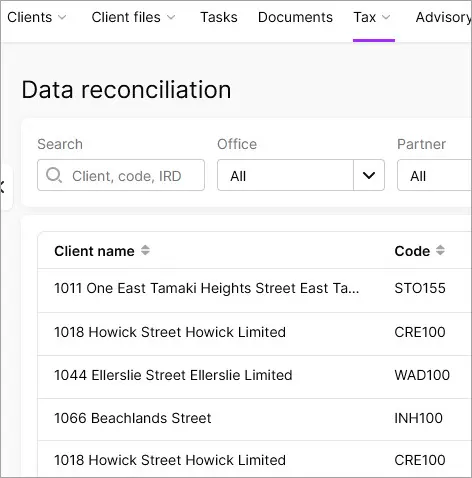
Check each tax type and period year.
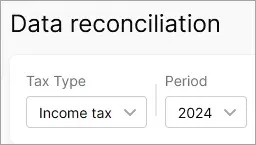
Add or reconcile transactions as required.
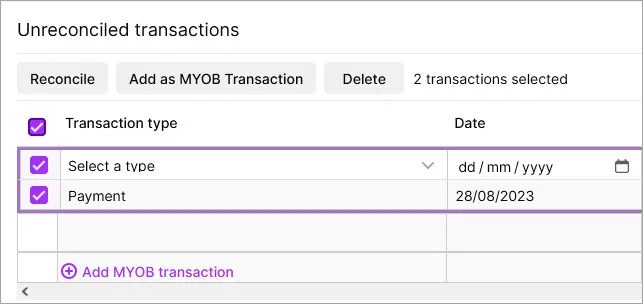
Repeat for each tax type, year and client.
1. Access the Data reconciliation list for the practice
Go to Tax > Data reconciliation.
The Data reconciliation page shows details of each client that has one or more transactions to be reconciled. Hovering over an Alert (yellow triangle) displays the number of transactions involved.

2. Apply filters to focus on content required
For example, Partner, Staff member and Unreconciled alert (IR transactions or MYOB transactions).
The Staff member drop-down includes names of staff who are recorded on the MYOB AE/AO desktop's Responsibility tab Team panel for a client. The drop-down shows their name and role, as defined on any client’s Responsibility tab. If you see names repeated, this is because they're recorded with multiple Team roles in AE/AO.
Learn more about Team responsibility.To focus on just the unreconciled transactions received from IR, select IR transactions from the Unreconciled alert drop-down. The filtered entries that are displayed involve transactions that haven't been automatically reconciled. This could be either because they didn't match the MYOB transaction, or there was no MYOB transaction to match against.
To focus on just those transactions that have been generated by internal processes or created manually by staff, and are currently unreconciled, filter on MYOB transactions from the Unreconciled alert drop-down list. These entries may include transactions that haven't eventuated and therefore should be considered for removal.
To filter the entries by a period range or single period, use the Period from and Period to drop-down lists.
You can export MYOB and IR transaction data from Data reconciliation to an XLSX spreadsheet file. This can be a handy way to review the data, and to make and share notes and comments.
3. Open the client to access their Data reconciliation details
Click the entry that you want to open from the Data reconciliation list. The entry for the period displayed in the Period column opens.
From here you can use the Period drop-down to navigate to any other tax year available for that client.
You can change the data displayed by selecting an option from the Tax Type filter. For individual entities, the Tax Type options are Income tax, Tax credits, Working for families or Student loan. For other entities, the Tax Type option is Income tax. This filter gives you information for evaluating your client's liability, giving you a complete picture of what a client’s tax position is for each tax type. These details will be included when preparing tax notices and tax returns, reducing the need for manual MYOB transactions or voluntary adjustments.
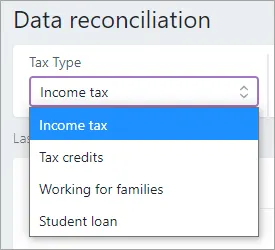
You can also perform an ad hoc retrieval of any new transactions that have been recorded by IR since the last bulk download of transactions.
4. Action any unreconciled transactions found
Review the transactions and determine what action to take. You may need to review other information regarding the client before you choose to accept the IR transaction.
Take the required action for the transaction (add or reconcile).
Ways to process unreconciled transactions:

When you open a Data reconciliation entry with unreconciled transactions, an alert at the top of the page displays the number of unreconciled transactions in each period, for each tax type.
Click the expand alert (a downward arrow) icon to display the full alert.

5. Review each year and tax type
Review each year to ensure there are no other outstanding transactions to process.
From the drop-downs, select each Period and Tax Type for the client.
-
You can add multiple transactions simultaneously by selecting their checkbox and clicking Add as MYOB transaction.
Assessment transactions require an additional step to confirm details, so these must be processed separately. -
You can reconcile multiple transactions simultaneously by selecting their checkbox and clicking Reconcile.
Assessment transactions require an additional step to confirm details, so these must be processed separately.
6. Return to the All clients Data reconciliation list
To return to the Data reconciliation view for all clients, select All clients in the client side menu.
Other functions
Adding comments in Data reconciliation
You can add comments to share information with other users in your practice. For example, you may want to flag an unreconciled transaction for investigation inside a Data reconcliation entry, and explain what needs to be checked. Or you could add a comment to the Data reconciliation entry itself to track status updates, or to help with audit records.
You can view and add comments:
inside individual Data reconciliation entries, or
before you open the entry on the All clients Data reconciliation list.
Information about the time, date and author of the comment is included with each comment. You can also add text formatting. There’s no limit to the number of comments you can add.
Comments on Data reconciliation entries in All clients view
Comments in the All clients view work independently to any comments on transactions inside a Data reconciliation entry.
A comment icon (a solid purple speech bubble) or no-comment icon (a speech bubble outlined in purple) in the Comment row indicates whether there is a comment.
Adding a comment:
Open the Data reconciliation page.
Click the comment icon (a solid purple speech bubble) or no-comment icon (a speech bubble outlined in purple).
The comment window appears.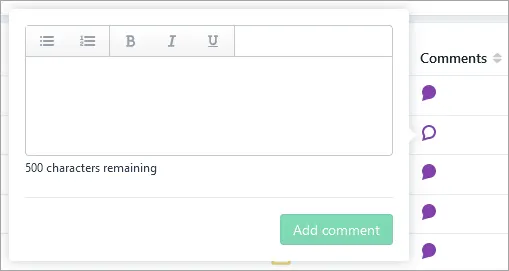
Enter your comment in the text field.
Don’t click out of the comment window before you’re finished making your changes. If you click out of the comment window, the window closes without saving the content.
You can use the toolbar above the text field to add formatting. The amount of characters remaining for your comment is displayed below the text field.
Click Add comment.
Viewing and deleting a comment:
To view a comment:
Open the Data reconciliation page.
Click the icon indicating a tax notice with comments (a solid purple speech bubble). All the comments that have been added to the entry are listed.
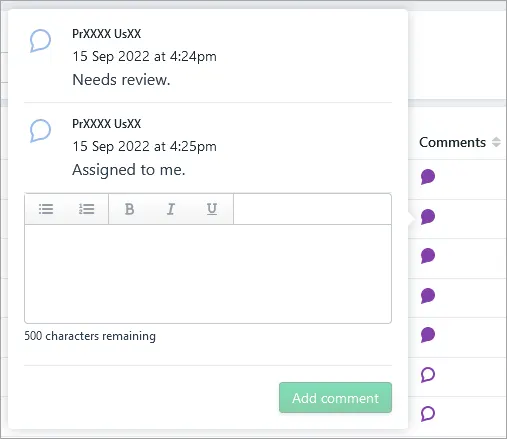
To delete a comment:
Hover over the comment. An ellipsis appears to the right of the comment.

Click the ellipsis. A Delete option appears.
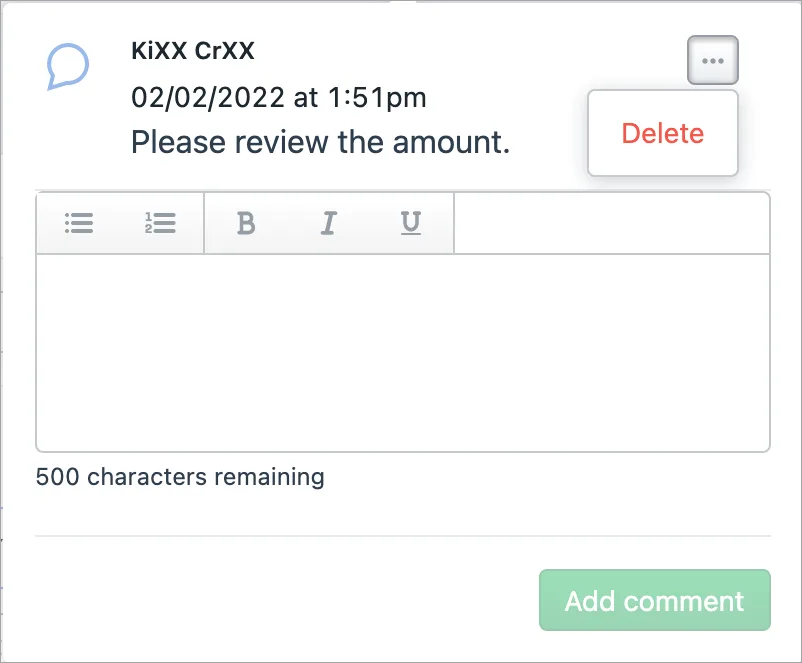
Click Delete.
Comments on transactions inside a Data reconciliation entry
Comments on transactions inside a Data reconciliation work independently to any comments in the All clients view.
A comment icon (a solid purple speech bubble) or no-comment icon (a speech bubble outlined in purple) in the Unreconciled transactions, IR statements, and Reconciled transactions table rows indicates whether there is a comment.
Information about the time, date and author of the comment is included with each comment. You can also add text formatting. There’s no limit to the number of comments you can add.
Adding a comment:
Open a Data reconciliation entry.
Click the comment icon (a solid purple speech bubble) or no-comment icon (a speech bubble outlined in purple). The comment window appears.

Enter your comment in the text field.
Don’t click out of the comment window before you’re finished making your changes. If you click out of the comment window, the window closes without saving the content.
You can use the toolbar above the text field to add formatting. The amount of characters remaining for your comment is displayed below the text field.
Click Add comment.
Viewing and deleting a comment:
To view a comment:
Open a Data reconciliation entry.
Click the comment icon (a solid purple speech bubble) indicating a tax notice with comments. All the comments that have been added to the tax notice are listed.
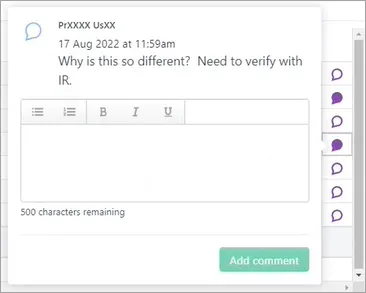
To delete a comment:
Hover over the comment. An ellipsis appears to the right of the comment.

Click the ellipsis. A Delete option appears.

Click Delete.
Manually adding an MYOB transaction
You can manually add an MYOB transaction and record it on the client’s tax year.

Attaching a document to a transaction
Click the Add documents (the paperclip) icon on the right-hand side of the transaction row and follow the prompt to attach a document. The Add documents icon changes to a purple colour to indicate it has one or more documents attached to the transaction.
When a tax notice is created to send to a client, the PDF is automatically attached to the MYOB transaction (being the expected payment). You can view this by clicking on the active paperclip icon.
Other information
Data Reconciliation transactions and where they're used
The flow of transactions within the Compliance areas of MYOB Practice tax, and where they're used, depends on their source (MYOB or IR) and whether they're unreconciled or reconciled. Here's a general guide:
Transaction type | Used in MYOB Practice tax |
|---|---|
Unreconciled IR Assessment (RIT) | No |
Reconciled IR Assessment (RIT) | Yes |
|
|
Unreconciled MYOB Calculated RIT (Tax return) | Yes |
Reconciled MYOB Calculated RIT (Tax return) | No* |
|
|
Unreconciled IR transaction (non-RIT, e.g. payment, transfer, etc.) | No |
Reconciled IR transaction (non-RIT, e.g. payment, transfer, etc.) | Yes |
|
|
Unreconciled MYOB transaction (non-RIT, e.g. payment, transfer, etc.) | Yes |
Reconciled MYOB transaction (non-RIT, e.g. payment, transfer, etc.) | No* |
* Any time an MYOB transaction is reconciled, MYOB Practice will always use the reconciled IR transaction instead.
See also the table in the sync tax return data section.
Tax return calculations
Tax return details are based on the tax return and any transactions (for example, transfers) that are part of the return or are recorded in Data reconciliation for that year. The Data reconciliation transactions used are generally a mix of unreconciled MYOB transactions and reconciled IR transactions.
Tax notice calculations
For RIT, MYOB Practice uses the calculated figure from the completed or filed tax return. However, once the RIT figure's been reconciled, MYOB Practice will use the IR figure instead.
For other transaction types (for example, payments or transfers), MYOB Practice will use IR transactions if they're reconciled as well as all unreconciled MYOB transactions.
Learn more about provisional tax notices and terminal tax notices.